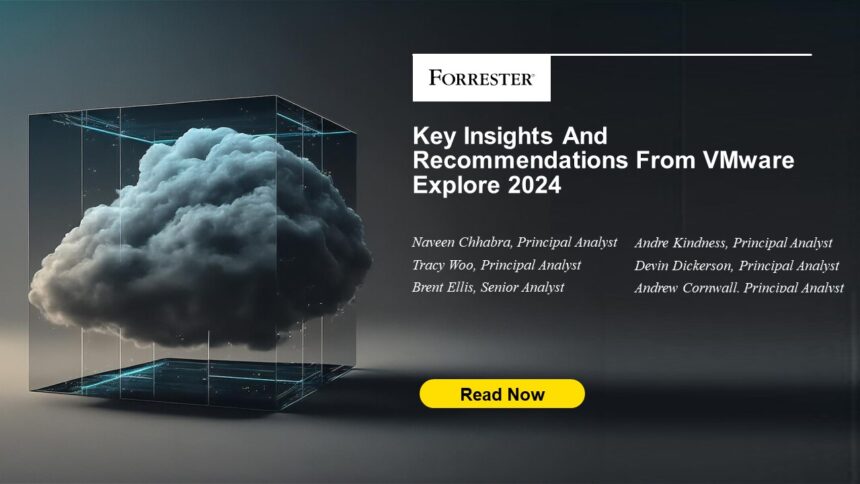VMware Explore 2024 began with Broadcom CEO Hock Tan reannouncing a significant departure from the previous VMware direction (embracing hybrid cloud) to a singular focus on making private cloud a success. Much like hyperscalers deliver an integrated set of infrastructure services, Broadcom is targeting integrating compute, storage, and network resources. It is aiming at making it easier for tech leaders to use the infrastructure by selling two major SKUs: vSphere Foundation (VVF) and VMware Cloud Foundation (VCF).
Andre, Andrew, Brent, Devin, Tracy, and I attended the annual VMware Explore conference to learn the latest. Our collective observations are that VMware:
- Has a remodeled vision of a private cloud that is daunting. VMware is articulating a new vision for private cloud. The VCF team has set audacious goals of integrating erstwhile VMware products to mimic a public cloud experience on-premises — in short, a public cloud software experience where you bring the hardware. We say audacious because of the following reasons: 1) VMware is redefining the private cloud vision it sold over the last decade; 2) the VCF product family needs use case-specific integrations; 3) VMware has reduced and reshuffled the VCF R&D engineering team; and 4) budget prioritization (across underlying products) isn’t going to be easy. The new vision begs a question: How quickly, cost-effectively, and competitively can it build the said integrations across the family of infra domains and IT operational tools?
- Is building a businesswide secure networking fabric to enable VCF. VMware stands out as one of the only vendors that can deliver security, networking, and visibility capabilities across WAN and within private cloud, public cloud, and the edge. The success of any cloud is the connectivity within and to/from it. Thus, VMWare has shifted into overdrive, integrating together NSX, vDefender, Avi Networks, CA, AppNeta, Symantec, and VeloCloud. The tough decisions have yet to be made on which parts will be the base components within VCF and what will be considered extra capabilities at extra charges.
- Aims to take advantage of trends promoting distributed AI workloads with software-defined edge. In contrast to other Explore announcements that consolidate capabilities into a packaged offering, members of VMware’s edge business took care to note their independence from VCF as a product line and innovation stream. The announcements in this category were networking- and infrastructure-centric, focusing on improved connectivity, traffic management, and interoperability with telco and satcom offerings. The strategy is decidedly not “If you build it, they will come,” as we have seen with other edge companies and telcos investing in points of presence and managed infrastructure. Instead, VeloCloud and the VMware Edge Compute Stack seek to optimize what customers already have in place and enable distributed data and applications to enable AI capabilities at the edge.
- Will need to answer lingering questions about the future of Tanzu, even as it looks sharp today. Broadcom has simplified Tanzu Application Platform and Tanzu Application Service into a single VMware Tanzu Platform. If you’re a VCF customer wanting to experiment with K8s, Tanzu Platform promises a straightforward way to start. Honda joined VMware in a session to show Tanzu Platform rapidly taking an app from a developer’s laptop to an AWS production environment. A VMware representative claimed that organizations could slice off the time it takes to go live by orders of magnitude, and the procedure is simple. If you don’t use VCF today, Tanzu Platform might be just as compelling. But with the change in focus to on-prem, you should ask how long Broadcom will maintain integrations with the hyperscalers as it does today.
- Will find that enabling license portability will not be as easy as it sounds. VMware aims to allow you to run the VMware stack anywhere — on-premises, VCF services at a managed service provider, or a hyperscaler. Though VMware can logistically and operationally achieve this easily, technically, it is far more challenging to port all underlying VCF products to multiple hyperscalers while maintaining feature parity. You will need to address two prerequisites: 1) porting your business applications across and migrating these apps to a hyperscaler-specific VCF and 2) subscribing to the VCF package, as the VVF package is not available through hyperscalers.
- Failed to show a commitment to the partner ecosystem. All the prior VMware events boasted a full show floor, with tech vendors demonstrating integrations and capabilities on top of VMware technologies. This year, the audience clearly missed the tech partner vibe, as only a few partners joined the show and even diamond sponsors limited their booth sizes.
What It Means For You
Hock Tan’s declaration that “the future is private cloud” is directly reflected in new product offerings and a new innovation roadmap. All divisions are geared toward supporting and providing capabilities that enhance VMware’s private cloud capabilities. For enterprises that have a hybrid cloud strategy and investment in public cloud, bear in mind that VMware product development will not be focused on managing and supporting public cloud as it did in the past. Therefore, tech leaders will need to:
- Decide whether VMware’s direction aligns with their own. It might or might not seem like a trivial question, but it is a critical question for your future investments in VMware. The VMware faithful have either bought into Tan’s vision of a private cloud software stack, or they have nowhere else to go.
- Determine the impact of license portability. VCF is a premium package for companies to put all their technology eggs in a VMware basket. It is unlikely for small and midsized businesses to absorb the higher costs and dependence. The fallout is a major disruption, as customers who can’t stomach the additional cost and don’t need the full package adopt other solutions.
- Double down on demands for a hybrid environment. While VMware may see a future of almost exclusively private cloud, the hyperscalers are adapting to the realities of a hybrid environment. Just as VMware and AWS customers pushed Pat Gelsinger and Andy Jassy to join hands, tech leaders must be clear about their business and technology demands and put those forward to VMware and other tech providers.
The announcements at the event showed that VMware leaders are optimistic, but they also recognize the many challenges ahead and are working to address them. The real question is whether VMware has the capacity to remake itself or whether it has sufficient time to make needed changes before taking on the additional strain of becoming the centerpiece of Broadcom’s software division.
As always, we’re here to help. If you’re a Forrester client, request an inquiry or guidance session with me to review your current state, future plans, and overall strategy.







